Nexus 7 (2013) - Mini Review
by Brian Klug on July 27, 2013 12:54 AM EST- Posted in
- Tablets
- Snapdragon
- Qualcomm
- Android
- Mobile
- APQ8064
- Nexus 7
- Android 4.3
The real highlight of the new Nexus 7 is of course the much higher resolution display. At 1920x1200 the Nexus 7 is now the highest resolution 7-inch tablet. This new IPS panel is made by JDI (Japan Display Inc) and boasts better viewing angles, 30 percent more gamut than the previous one, and of course better dot pitch of 323 PPI. Alongside that the new Nexus 7 also doesn’t have the always-on dynamic brightness and contrast (NVIDIA Prism / smartdimmer) that many including myself found frustrating with the original Nexus 7. On the new version the equivalent functions are enabled only during full screen video playback. This is a huge improvement since with the feature enabled on the previous Nexus 7 I always felt that greens were undersaturated and some dynamic range clipped.
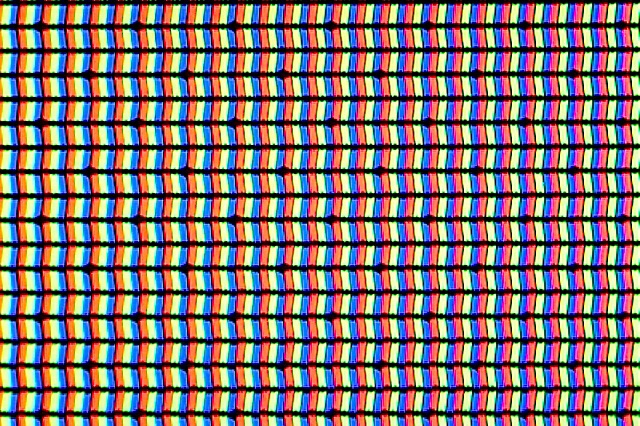
I did a lot of asking around about how Google calibrates its panels, and was told that in the case of the Nexus 7 there are two stages. The first is the calibration done by JDI on the panel at a high level, the second is an additional calibration at time of manufacture, per device. This sort of thing is relatively standard, but I’ve always been curious about what stages cost extra money – certainly it’s a baseline expectation for the panel supplier to supply a close-enough LUT, but getting Delta E even lower I’m told requires additional expenditure.
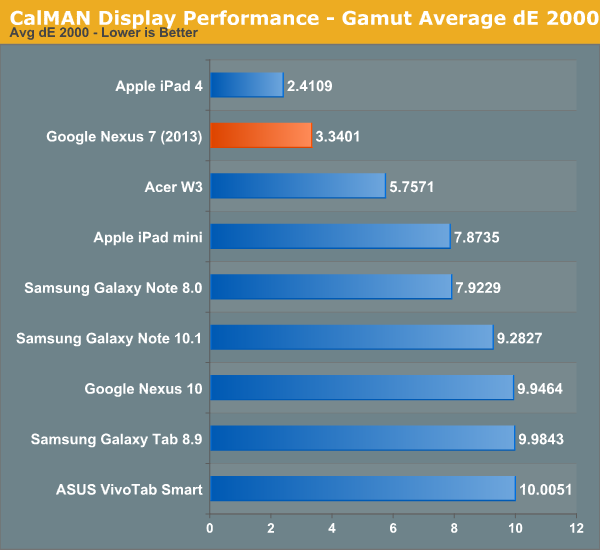
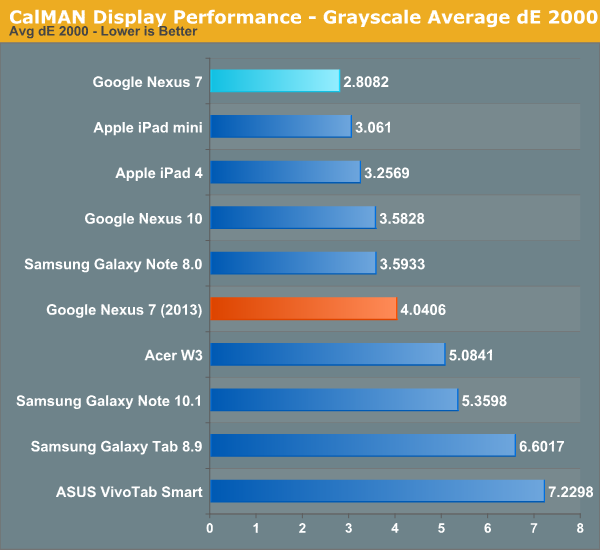
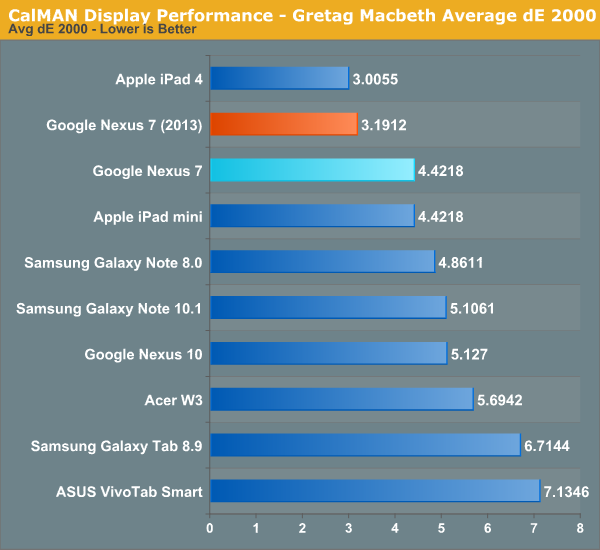
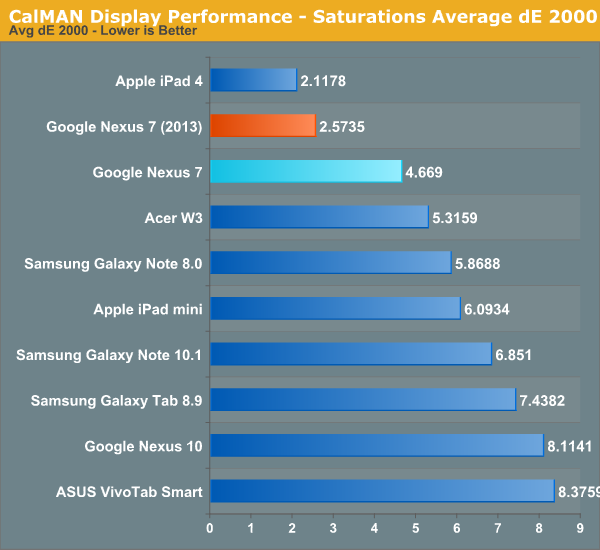
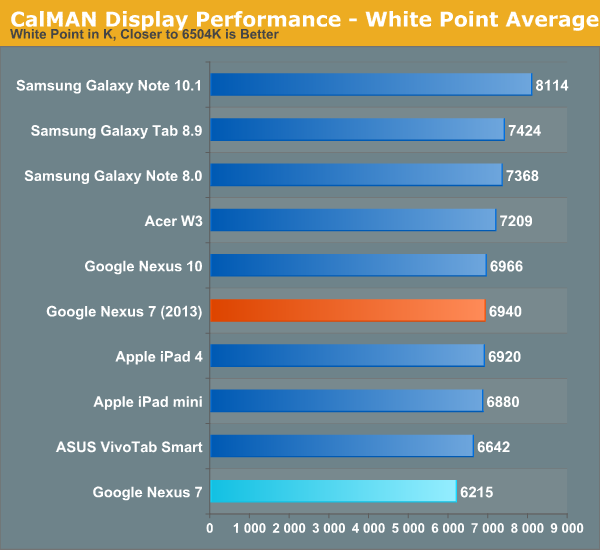
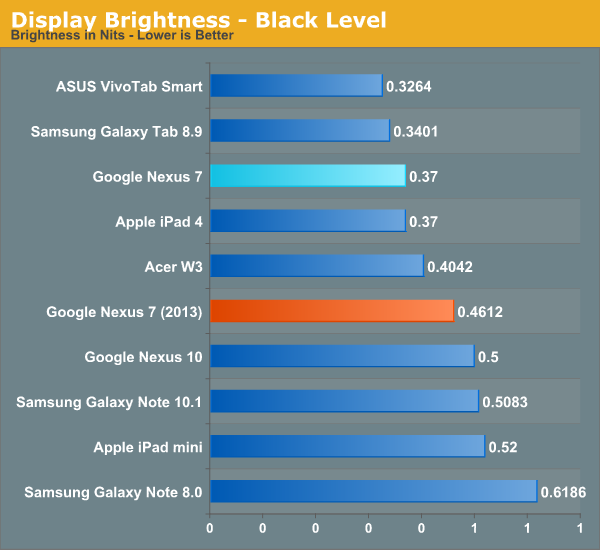
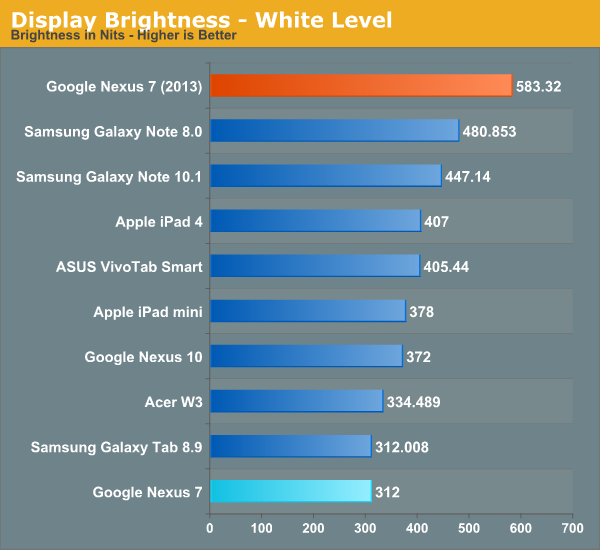
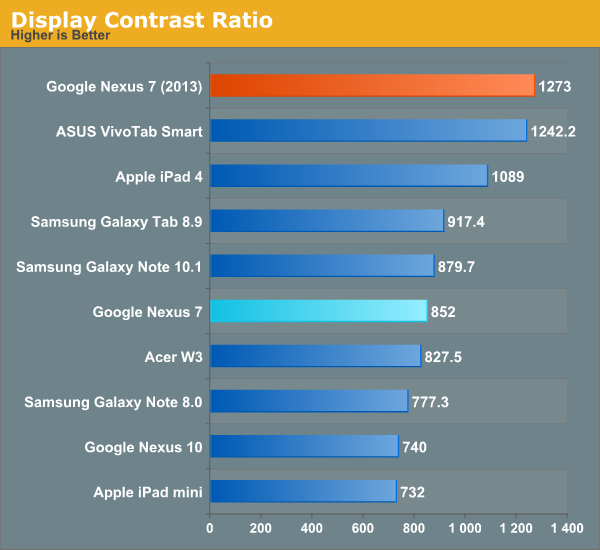
It turns out that the new Nexus 7 is actually very close to sRGB this time around, with overall gamut being just a bit bigger than the sRGB color space. In the GMB Delta-E and saturations Delta-E measures, arguably the two most relevant for color accuracy, the new Nexus 7 is second only to the iPad 4, and better than the iPad Mini in color accuracy, a significant step forwards from its predecessor.
The new Nexus 7 also goes very bright, up to 583 nits, with excellent contrast of 1273. This is again not achieved using any dynamic contrast cheating since those functions are thoughtfully disabled.
On the display side of things I’m very pleased with how far the Nexus 7 has come, and it’s obvious that display quality was a big focus for the 2013 model.















252 Comments
View All Comments
darkich - Sunday, July 28, 2013 - link
That's right. Except that..USB OTG functionality is again absent on the nexus 7.It really baffles me.
Sure, there's rooting, but Google REALLY should've add the USB support out of the box
andrewmu - Monday, July 29, 2013 - link
It's not absent, unless you mean it doesn't ship with the cable. I've got USB OTG working fine on my 2012 Nexus 7 with keyboard, mouse, etc. It's annoying it doesn't natively support USB storage, but that's a more specific issue.broberts - Tuesday, July 30, 2013 - link
OTG is reportedly functional on the 2013 model. Further, WiFi lets you connect to other devices on your LAN and to the cloud. The lack of an SD slot is at best a quibble.JayGrip - Wednesday, July 31, 2013 - link
I have a 2013 nexus 7. I couldn't get otg working but in looking around settings found a setting for hotspot which turns the 7 into router. Es file exployer allows you to run a ftp server and its fast. So I use otg on my note2 to transfer files to nexus 7. 1.2 gig movie about 3.5 minutes.user777 - Thursday, August 1, 2013 - link
I have Nexus 7 2012 and there is no problem to use USB OTG cable + USB stick (or Transcend USB stick with microSD+SD card slot). I use Total Commander+USB Stick plugin (free). It is possible to open any doc/pdf/jpeg/avi/mp4 file.It is possible to share any folder or external HDD at your laptop and to use like WiFi Network LAN storage using ES File Explorer. It is possible to play any movie using streaming (without downloading) from the Network LAN storage (MX Player or BS Player). It is even possible playing movie from WiFi FTP server.
kyuu - Saturday, July 27, 2013 - link
Not sure if serious or just trolling...Krysto - Saturday, July 27, 2013 - link
Apple doesn't use expanded memory either, and they've been selling the tablet at the same high price for years now, and it still only has 16 GB of storage. I'm starting to wonder if they'll ever change it this decade. That $500 should come with 32 GB by default by now.fokka - Saturday, July 27, 2013 - link
yes, but then people who'd also want to _use_ their ipad wouldn't have to purchase the higher-tier 32gb version.to me, a business like this is a scam. i can somehow understand why apple is doing this. they have their itunes ecosystem with sync and whatnot, so expandable memory just doesn't fit in their concept.
but on android it's just different, since expandable memory works out of the box, if an sd-slot is included.
so the only reason is to upsell you to a more expensive sku and in the same time severely limiting total storage, which for me as a music-lover and his 50gb library, is reason enough i will never even think about buying your product.
which is a shame, because the rest of the nexus 7 looks mighty fine.
jt122333221 - Saturday, July 27, 2013 - link
You have about 9k songs, based on a 6mb size for each song. Upload them to Google Play (20,000 songs can be uploaded), download the ones you listen to most to your tablet, and stop complaining - Google's not going to use expandable memory in the near future, as they are trying to push their cloud services. It's (IMO) working well, and their cloud services are great products. The only thing that needs to change is Carriers and their metered data plans.deathdemon89 - Saturday, July 27, 2013 - link
How does the fact that they're "not going to use expandable memory in the near future" make their decision any less wrong? None of what you said can be used as a justification - in fact, it highlights a very real issue. Cloud services, no matter how "great" they are, can NOT compete with the convenience, accessibility and reliability of expandable storage. This holds even truer in non-U.S. markets where data services are even less developed. At the end of the day, the theoretical risks of cloud data are far higher than the equivalent risks of expandable storage.